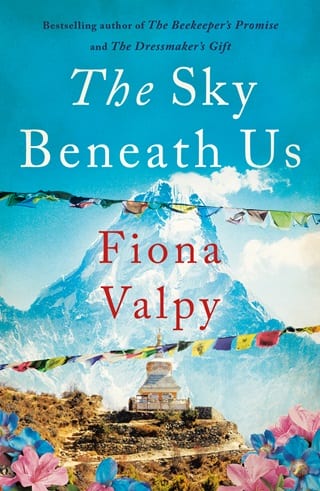Daisy: April 2023
The Hillary Bridge stretches away before us, festooned in its streamers of prayer flags. We ease our rucksacks from our shoulders while we wait for a lengthy train of yaks to plod their way across it towards us, setting it swaying, and Mara grins broadly. ‘It’s so awesome, Mum. I still can’t believe you did this trek on your own.’
I laugh, stepping aside to allow the porters following the yaks to pass by with their broad bamboo baskets. ‘Well, I did have the help of a number one best Sherpa, of course.’
Tashi nods, acknowledging the compliment, and smiles benevolently. ‘Your mum, she do twice this distance for her trek, no worry. Strong as a yak,’ he tells Mara.
‘I’ll take that as the highest praise,’ I say, as we shoulder our packs once more and step out on to the bridge. ‘Yaks are the most wonderful creatures.’
We’re on our way to Phortse, where Sorcha will be waiting for us. She’s been living at Tashi and Dipa’s lodge for a month now, carrying out research for her undergraduate dissertation on the effects of climate change in the Khumbu valley.
Mara almost skips across the bridge. I follow a little more sedately, pausing in the centre to feel the wind sweep over my face and scatter my thoughts into the sky beneath us, mingling with the prayers from the fluttering flags. Far below, the milky-turquoise river winds its way through the mountains. And then I walk onwards, the bridge bouncing beneath my feet as I head for the other side.
‘I wonder how Sorcha managed to cross that,’ says Mara as she snaps some photos, looking back the way we’ve come. ‘She’s never had much of a head for heights.’
‘She do okay,’ replies Tashi. ‘Sonam took her pack, led the way. I walk behind her. No worry.’ Mara and I exchange a knowing glance. Sonam’s name seems to feature rather often in Sorcha’s messages, and he’s apparently been in no great rush to return to Kathmandu while she’s been in the village.
‘You ready for Namche Bazaar tonight and tomorrow, Miss Mara?’ Tashi asks. ‘Many young people there, now climbing season open again. Irish pub, fancy coffee, nightclub?’
‘I think I’ll just be looking forward to my supper and a good night’s sleep by the time we get there if the rest of the way’s as steep as this,’ she replies, hands on her hips as she puffs her way up the path.
‘Just put one foot in front of the other, slowly, slowly. You get there, no worry.’
The familiar mantra buoys my spirits, helping me on my way. The trek seems easier this time. Perhaps it’s psychological – the path is a familiar one and I know it’s possible for me to make it. Or perhaps it’s the fact that my heart is so much lighter this time around, even if my pack is heavier, full as it is with gifts for my friends.
It’s taken three years to be able to travel freely again and return to the Khumbu. Three long years for the world to get the pandemic under some sort of control. Miracles have been worked, with vaccines being developed and programmes rolled out, with countries working together to try to halt the spread of the virus. But the pain and the loss and the fear have left their legacy too. Livelihoods have been lost, mental health has suffered, and the cruel illness continues to kill the vulnerable and the elderly. My mum’s never regained her old strength after she had Covid and then it took Davy from us. Her exhaustion has meant she’s not been able to make the trip with us. Three years ago, she might have managed it, despite her age. But now she’s tired all the time, and her worn-out lungs make her susceptible to any further infections, so she can’t risk international travel. It’s hard to tell whether it’s her physical or her mental strength that’s been most affected. Either way, the virus has had a lasting effect on her. Jack’s stayed behind at Aultbea to look after her, as well as Elspeth, and he’s promised Mara he’ll look after her garden, too, while she’s away.
The music school has reopened now, so that’ll be keeping them all busy. It’s a consolation to know the rooms of the big house resound once again with the sounds of practice and performance.
When the second lockdown hit on Boxing Day of that same year, I think we all found it way tougher than the first one. Hope became the life jacket we put on each day to get ourselves through. We’d had to resign ourselves to the fact that the music school wouldn’t be reopening any time soon. In fact, it remained closed for the rest of that academic year, but we rolled out a programme of online classes to help keep our teachers and pupils afloat. Performances by the Ardtuath Online Orchestra buoyed spirits the whole world over, judging by the messages we received.
The music-making helped. And so did the news from the botanic gardens in Edinburgh and Kathmandu. Martin Walker’s colleagues in Nepal had received the collection of seeds from Themi and sent some of them back to him. Both teams had begun to cultivate them, hoping that between them they could coax Violet’s discoveries back into life. When the first photos arrived from Kathmandu of tiny green shoots pushing their way determinedly into the light, we whooped and cheered. And then Martin sent pictures from the Glasshouses in Edinburgh of the same thing happening, and we rejoiced again, knowing Violet’s legacy had survived, against all the odds, and her name would live on for all time.
Our other source of hope was Mara’s garden. I loved working there alongside her. She set up a rota so that people from the local area could come and help in it, too, just a few at a time to keep everyone safe, paying them in produce as well as the satisfaction of working together as a community in the fresh air. It offered some much-needed socially distanced human connection for those who were isolated. In the polytunnels and our milder west coast climate, tempered by the Gulf Stream, we managed to grow crops all year round. In winter, fresh greens like kale, chard, herbs and cut-and-come-again salad leaves were all welcome additions to the staples of potatoes, turnips, carrots and leeks that she grew out in the open in Davy’s old vegetable beds. Mara experimented with traditional techniques of companion-planting, enriching the soil with seaweed and resting areas so they’d remain productive. Everything not only thrived, it tasted great as well.
As Sorcha continued her university studies online, she grew increasingly interested in the impacts of climate change in fragile places like the high-altitude areas of the world, where conditions already meant species were being threatened. Over the supper table, she’d tell us about what she’d learned.
One evening, I described the snowstorm that had engulfed Phortse the day I arrived there and told them how worried the villagers had been about what it meant for the growing season and their crops that year. Sorcha nodded, considering the issue in her quiet way. But Mara, who’d been in the process of helping herself to some more of her home-grown potatoes, suddenly looked up and said, ‘Greenhouses. They need greenhouses, Mum. It’ll help protect their crops from these new extremes of weather and expand the range of things they can grow, just like we’ve done here.’
We set up a video call with Tashi and Dipa the next morning, where they echoed our enthusiasm for the project and said they’d consult the local committee. A couple of hours later, Tashi rang back to say everyone loved the idea and an area of common ground had already been identified as a possible community garden. Sorcha and Mara did some research to find the most suitable materials to use and the best way to build structures that could withstand the extremes of weather in the Khumbu valley, and we hatched a plan to raise the funds needed to bring greenhouses to Phortse.
After our two-night acclimatisation to the altitude in Namche Bazaar, Mara, Tashi and I set out on our final day’s trek to reach the village. Tashi insists we stop for tea at Kyangjuma, where – miraculously, given the remoteness and the altitude – there’s a bakery selling the most delicious cinnamon buns I’ve ever tasted. It had been shut last time we walked this way, so I’d missed out. It’s a popular spot, crowded now with guides, trekkers and climbers, but we find a seat at a table in the sunshine.
‘Maybe I’ll come back and do some climbing one of these days,’ says Mara, taking a large bite of her pastry. She gathers up the last crumbs and licks them from her fingers, looking across towards the formidable, soaring peak of Ama Dablam. ‘Actually, on second thoughts, I think I prefer walking through the mountains rather than having any great desire to stand on top of them.’
Tashi nods his approval. ‘You show proper respect to the mountain gods. Your mum tell you about that? She very good teacher.’ He begins to collect up our cups to take them back inside the café.
We reach the fork, with its half-hidden signpost, and take the left-hand path, leaving the main route behind and climbing towards Mongla beneath a canopy of rhododendron leaves. Even though the going is harder now, it’s far more peaceful. The noise of helicopter blades chopping the air into pieces fades into the distance and the only people we encounter on this path are a few porters carrying supplies to the remoter villages. Up and up we trudge, our chests heaving as we gasp in mouthfuls of the thin air. And then, at last, we round a bend in the dusty track and see the prayer flags of Mongla ahead of us. Knowing we’ve made it to the highest point on our trek brings a surge of energy to our tired legs as we clamber up the final stretch to our lunchtime teahouse.
Once we’ve fortified ourselves with bowls of soup, we re-shoulder our packs and carry on, downhill now, the path leading us back towards the blue-green river tumbling its way along the valley floor.
Around one more shoulder of rock, the first glimpse of Phortse awaits. Mara stands with her hands on her hips, drinking in the distant view of the little village, its terraced fields clinging to the hillside dwarfed by the soaring walls of rock that surround it.
Then, without saying a word, she turns, reaching out her arms, and draws me into a tight hug. And I understand. It’s her way of expressing it all: the joy and the relief of having made it; the significance of this place and the insignificance of mankind within it; and our sheer, incredible awe and admiration for the Sherpa people of Phortse, whose qualities of strength, resilience and generosity of spirit allow them to live here, at the very edge of what is possible.
Mara then regains her usual matter-of-factness.
‘Don’t tell me we have to walk all the way down there to the bottom of the valley and then climb all the way back up again to get to the village! Honestly, where’s another death-defying bridge when you need one?’
Tashi smiles beatifically. ‘No need for bridge. When you can see home, feet carry you more quickly because heart grows lighter.’
And he’s right. Because about an hour later, as we pick our way between the branches of the gnarled trees guarding the approach to the village, our aching legs and labouring lungs are completely forgotten when we catch sight of Sorcha, Sonam, Dipa and a small crowd of others standing at the gateway, smiling and waving, welcoming us.
Our packs are taken from us by a couple of little boys who run on ahead, up the paths between the stone walls leading to the lodge, while we follow at a more leisurely pace. We walk alongside the mani wall, its ancient stones a testament to so many goodbyes already said, the ones who have gone before us still here in our hearts. As we approach the lodge, I’m gratified to see there’s still a neat stack of yak dung pancakes in the porch.
And then a white-haired woman, as gnarled and as beautiful as a rhododendron branch – just as her mother, Violet, was before her – emerges on the arm of her granddaughter and we step into the warm embrace of our Sherpa family.
Two days after our arrival, the whole village gathers to watch for the helicopter. There’s a buzz of anticipation, accompanied by much laughter. This is a day of celebration for all. At last we hear the sound of the rotors, and it comes into view. It’s quite a sight, as the materials for constructing two sizeable greenhouses dangle beneath it from a longline. I hold my breath as they’re gingerly lowered and set down safely on the ground. Then I put an arm around Mara and Sorcha, standing one on each side of me, and squeeze them tight. They look as happy as I feel to see the greenhouses reach Phortse.
What had begun as an idea over the supper table at Ardtuath one evening quickly turned into a project involving the whole community back home. We started small, with Mara raising funds from the sale of her fruit and veg at a roadside stall, along with pots of jam and chutney made by my mum and Elspeth. Then we raised money from the online concerts performed by the music school’s lockdown orchestra. Perhaps it was our refusal to allow a second lengthy lockdown to stop us that people found so inspiring, or perhaps it was the realisation that a remote Himalayan community was being hit so hard by the effects of climate change in addition to the pandemic and needed our help. Either way, the project began to grow arms and legs and people got involved the whole world over. Jack told his sailing friends on the other side of the Atlantic and they sent donations and helped spread the word. And so, as lockdown fenced us in and restricted our movements, we expanded our horizons in different ways, escaping by helping others. Instead of the pandemic constraining us, it gave us the time and space to find new meaning in our lives, reminding us of both our fragility and our resilience, of what it really is to be human. And it seemed others shared our determination because the messages of support and the donations poured in, even at that time when so many had lost so much and were struggling financially.
It’s been another bitterly cold spring in the Khumbu – the greenhouses have arrived just in time. Now, once the helicopter pilot has set the materials down safely, he lands and ducks out from under the blades to hand over the rest of his precious cargo. We hurry forward to take the cellophane-wrapped trays of seedlings from him and get them into the shelter of the community hall, where they’ll be nurtured until the greenhouses have been assembled and they can be planted out.
These plants are a gift from the botanic gardens in Kathmandu, a few food crops to begin planting out in the greenhouses. Later in the season, once the weather is warmer and the rains have come, some of Violet’s plants will be reintroduced to the mountains as part of a wider conservation project. The botanists are especially interested in two of her findings. One is a variety of yew, which has been found to contain a substance that can be used to fight certain types of cancer. And the other is the high-altitude, prickly little blue poppy, Meconopsis horridula . It turns out it contains a medicinal compound that is effective in treating bruises and circulatory problems. The latest research has found it has the potential to be used in the treatment and prevention of heart attacks. If it can be grown here successfully on a wider scale, it just might provide a whole new income stream for these remote mountain communities. And then, perhaps, the inhabitants won’t be so dependent on risking their lives and angering the mountain deities in order to be able to provide for their families.
Some of the Sherpa guides have come home, taking time out from their work on the mountains, to help with the construction of the greenhouses. They walk forward to shoulder the heavy materials and carry them up the hill to the site of the new garden, led by a gaggle of excited children dancing ahead, with the rest of us following on behind.
In a couple of months’ time, when the early-summer rains arrive, a team from the Edinburgh Botanics are planning to join their Nepalese colleagues and travel out to explore the Valley of Flowers. And Sorcha will show them the findings from her research. She’s already been offered a position as their newest employee when she’s finished her degree course. Her job means she’ll be spending her time between the botanic gardens in Edinburgh and Nepal, part of the team working to conserve and protect the biodiversity of this place for future generations.
And so it fills me with great joy – and not a little maternal pride – that both my girls are following in Violet’s footsteps, nearly a century on.
 Fullepub
Fullepub 



